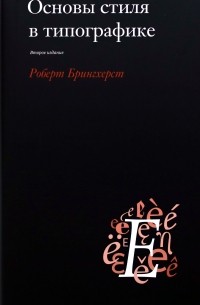
Автор
Роберт Брингхерст – лучшие книги
- 2 произведения
- 8 изданий на 3 языках
По популярности
-
Основы стиля в типографике Роберт Брингхерст
ISBN: 978-5-94056-030-2 Год издания: 2013 Издательство: Издатель Дмитрий Аронов Язык: Русский Эта книга, впервые изданная в 1992 году, быстро стала профессиональным бестселлером и остается им в мире англоязычной типографики до сих пор. Ее авторитет был сразу признан в типографическом сообществе как приверженцами классики, так и сторонниками авангарда. Она переиздавалась с исправлениями и дополнениями много раз, была переведена на итальянский, греческий, португальский и польский языки. В 1996 году, а затем в 2005-м, книга была переработана и существенно расширена.
Второе русское издание этой книги дополнено главой 10, параграфами 9.2, 9.4, приложением а, рядом статей в каталоге шрифтов, а также другими материалами, добавленными автором в оригинальную версию 3.2, вышедшую в 2008 году. Русский перевод снабжен примечаниями редактора, делающими некоторые детали более понятными для российского читателя.
"Что такое хорошая типографика? Каковы критерии ее качества? Как добиться лучших результатов в оформлении текста? Книга Брингхерста помогает во всём этом разобраться. Задавая профессиональные стандарты качества набора, она утверждает высокие принципы классической типографики - восходящие к исторической традиции и в то же время обращенные к современной практике, чей инструментарий продолжает развиваться у нас на глазах. После долгих десятилетий застоя, граничащего с клинической смертью, русское издание книги Брингхерста обещает стать вехой в развитии отечественной типографики". Максим Жуков -
The Solid Form Of Language: An Essay On Writing And Meaning Роберт Брингхерст
ISBN: 978-1894031882 Год издания: 2004 Издательство: Gaspereau Press Язык: Английский “Drop a word in the ocean of meaning and concentric ripples form. To define a single word means to try to catch those ripples. No one’s hands are fast enough.” With this concise and broadly informative essay, renowned poet, typographer and linguist Robert Bringhurst presents a brief history of writing and a new way of classifying and understanding the relationship between script and meaning.
Beginning with the original relationship between a language and its written script, Bringhurst takes us on a history of reading and writing that begins with the interpretation of animal tracks and fast-forwards up to the typographical abundance of more recent times. The first four sections of the essay describe the earliest creation of scripts, their movement across the globe and the typographic developments within and across languages.
In the fifth and final section of the essay, Bringhurst introduces his system of classifying scripts. Placing four established categories of written languagesemographic, syllabic, alphabetic and prosodicon a wheel adjacent to one another, he uses the location, size and shape of points on the wheel to show the degree to which individual world languages incorporate these aspects of recorded meaning. Bringhurst’s system is based on an appreciation that indeed no one’s hands are fast enough and that no single script adheres to or can be understood within the confines of a single method of transcription.
Readers will find this combination of anthropology, typography, literature, mathematics, music and linguistics surprisingly accessible and thought provoking. The text is accompanied by diagrams and typographic examples that make for an experiential study of the relationship between writing and meaning. -
The Black Canoe: Bill Reid and the Spirit of Haida Gwaii Роберт Брингхерст
ISBN: 0888946791 Год издания: 1991 Издательство: Douglas & McIntyre Язык: Английский It is rare for a single work of sculpture to become the subject of a book at any time, much less at the moment of its installation. But Bill Reid's Spirit of Haida Gwaii is no ordinary sculpture. Commissioned for the courtyard of the new Canadian chancery in Washington, DC, it sits directly across the street from the National Gallery and is destined to become one of the major artistic landmarks of the capital and of the North American continent.
Of Haida and white parentage, Canadian artist Bill Reid has spent his life resurrecting the indigenous Northwest Coast tradition in the visual arts. Yet has never lost touch with the European media and techniques in which he was trained. He is equally famed for his totem poles and other large pieces in wood and bronze, and for his work on a minute scale in precious metal.
The Spirit of Haida Gwaii is a black bronze canoe, 6 metres long and filled to overflowing with the creatures of Haida mythology. Its passengers include the Raven, the Eagle, the Grizzly and his human wife, the Mouse Woman and the Dogfish Woman, among others. Amidships stands a human being, wrapped in the stylized skin of the mythical Seawolf, holding in his hand a smaller sculpture: a staff on which the story of creation, in Haida terms, is told.



